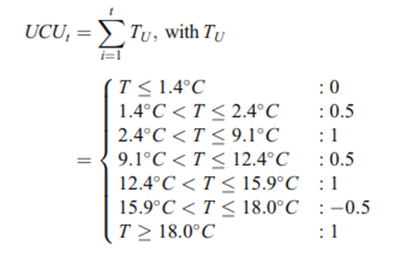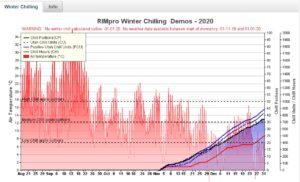Winter Chilling
Many commercially important fruit and nut trees require winter chilling. To avoid frost damage in the winter, the plants enter dormancy in the fall. They do not resume growth until a certain amount of winter chill has accumulated, fulfilling their chilling requirement. The physiological processes occurring in trees during winter chill accumulation are poorly understood. Models for winter chill accumulation are thus purely empirical rather than based on a functional understanding of tree physiology. Temperatures around 4 °C contribute most to winter chilling. Temperatures below 1 °C have no effect, and temperatures over 12 °C can even reverse the accumulated chilling.
Global warming will diminish winter chill accumulation and lowers the possibility to produce certain tree fruits in warmer climate zones.
Various models for winter chilling have been developed. As these models interpret the effect of temperature differences, the models react differently to the winter conditions in different climate zones. Results from one model cannot be “translated” directly into a value for another model.
RIMpro runs and presents the results of the four main winter chill models in parallel, based on hourly weather data. The Dynamic Model is regarded as the most accurate model and proposed as a world standard by experts.
- In the southern hemisphere, chilling is accumulated from April 1st to November 1st.
- In the Northern hemisphere, chilling is accumulated from October 1st to May 1st.
To use the model correctly, your weather data source should provide the weather data over this complete time range.
Chilling Hours Model (Chandler 1942)
Temperature is measured in hours since the start of the dormancy season. The Chill Hours accumulate with Temperatures between 0 and 7.2 C from the start of dormancy.

Utah Model (Richardson et al. 1974)
The Utah Model (Richardson et al. 1974) contains a weight function assigning different chilling efficiencies to different temperature ranges, including negative contributions by high temperature.

Utah Positive Chill Units (Linsley-Noakes et al. (1995)
South African researchers modified the Utah Model by ignoring negative chilling units accumulated over a 24-hour period. If negative chilling units are accumulated over a 24-hour period, the total is just “zeroed out.”
The Dynamic Model (Erez et al. 1990; Fishman et al. 1987a, b)
This model was initially developed for the warm winters in Israel
It assumes that winter chill results from a two-step process, in which an intermediate product is first formed in a process promoted by cold temperatures. Warm temperatures can destroy this intermediate product. As soon as a certain quantity of intermediate has accumulated, it is irreversibly transformed into a Chill Portion, which can no longer be destroyed.
RIMpro uses the formula directly as developed by The Volcani Center, Bet Dagan, ISRAEL.
